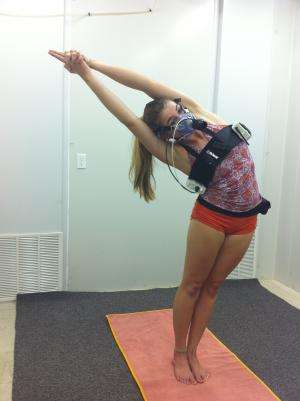'Hot' yoga yields fitness benefits according to researcher

Researchers at Colorado State University have produced some of the first scientific evidence that Bikram yoga, a type of "hot yoga," has beneficial effects on fitness.
They are also the first to quantify the number of calories burned while practicing this yoga.
Brian Tracy, an associate professor in CSU's Department of Health and Exercise Science, presented his lab's findings in May at the national conference of the American College of Sports Medicine.
Bikram yoga is a standardized 90-minute session featuring 26 postures and two breathing exercises performed in a room heated to 105 degrees Fahrenheit and kept at 40 percent humidity. In his most recent study, which was highlighted in recent online issues of Time and Glamour magazines, Tracy measured the body's response to a yoga session performed by 19 seasoned 18- to 40-year-old Bikram practitioners – 11 women and eight men.
He found that the participants showed elevated heart rates averaging about 160 beats per minute and core temperatures averaging 100.3 degrees F, all within a safe range. Tracy also found that the body's average metabolic rate, or calories burned, was roughly equivalent to walking briskly (about 3.5 miles an hour) for a full 90 minutes.
Some practitioners have reported burning as many as 1,000 calories in one Bikram yoga session, but Tracy said the figure in his study averaged about 460 calories for men and 330 for women. Differences in body size explained the caloric difference between the sexes.
According to Tracy, the previous higher calorie estimates are likely due to practitioners using a calculation based on their heart rate response during hot yoga, but that prediction equation is only appropriate for exercise at normal temperatures. Elevated temperatures in the hot yoga studio produce higher heart rates, which doesn't necessarily translate into higher metabolic rates or calorie consumption, he said.
"That prediction equation results in an inflated estimate of the calories being burned," he said. "We didn't predict calories burned, we actually measured metabolic rate for the first time. This number of calories burned can still contribute to weight loss with regular participation."
Tracy found that Bikram yoga has a variety of positive effects on fitness and lifestyle, and results vary: The participants' age, body mass, pace, yoga experience, weight, motivation, and other factors could result in higher or lower calorie-burning and weight loss. Those populations haven't been scientifically studied yet.
Tracy's study builds on previous groundbreaking research from his lab. In 2008, he led the first scientific study on the physiological effects of Bikram yoga, published in the Journal of Strength and Conditioning Research, which found that muscle control, balance and strength were improved in a group of test subjects who had never tried Bikram yoga before.
In that study, participants undertook an eight-week, 24-session yoga program and showed measurably better results than a control group that remained inactive. In a subsequent 2013 research paper in the same journal, Tracy and his co-authors reported that the subjects showed significant gains in spine, hamstring and shoulder flexibility and improved whole body strength, but cardiovascular performance and aerobic fitness remained largely unchanged, probably due to the brief training period and beginning healthy cardiovascular status of the participants.
Tracy's latest research was funded by Bikram's Yoga College of India and PURE Action, Inc., a yoga research and education nonprofit advocacy group, neither of which had prior review or control over the results of the study. In addition to collaborators Apurba Mukherjee from the Bikram College and Stacy Hunter from PURE Action, co-authors were CSU doctoral student Megan Fritz and research assistant Amy Grossman.
Tracy said that considering its popularity and volume of anecdotal positive health effects, there is a dearth of research on Bikram yoga; he and various co-authors have produced two of the five peer-reviewed papers that have been published on the physiological effects of the regimen. The paper on the new study, which would be the sixth, is still being drafted for publication.

















